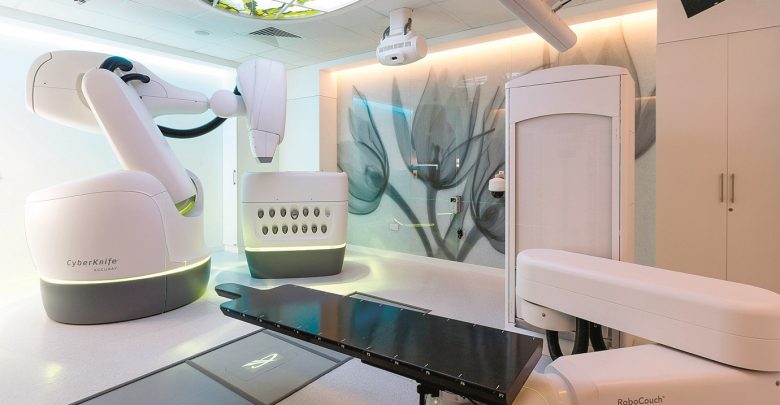
More than 100 cancer patients benefit from HMC’s CyberKnife unit
نجاح علاج أكثر من 100 مريض سرطان بنظام «سايبرنايف»
More than one hundred cancer patients have benefited from a state-of-the-art radiosurgery system installed in 2015 at Hamad Medical Corporation’s (HMC) National Center for Cancer Care and Research (NCCCR), HMC said in a statement Sunday.
HMC was the first healthcare organization in the region to offer treatment using the cutting-edge M6 CyberKnife robotic radiosurgery system. And NCCCR is one of a few
cancer care hospitals to have a system equipped with the M6 Incise Multileaf Collimator – specialist technology that further enhances the ability to target the radiation dose distribution.
CyberKnife, one of the most advanced forms of radiosurgery, is a painless, non-invasive treatment that uses a robotic arm to deliver highly focused beams of radiation to destroy tumors or lesions within the body. The flexibility of the robotic arm makes treatment possible for areas of the body that can’t be treated by other radiosurgery techniques, such as the spinal cord.
Compared to other radiosurgery techniques, CyberKnife offers several advantages to patients, including rapid relief from pain and other symptoms. Treatments are performed on an outpatient basis, with each treatment typically lasting between 30 to 90 minutes. The number of treatments varies depending on the tumor size, location, and shape. Recovery is often immediate, given the low risk of complications and damage to healthy tissue.
While not every patient is a candidate for CyberKnife treatment, Dr. Noora Al Hammadi, Chair of the Department of Radiation Oncology at NCCCR, said the revolutionary procedure delivers highly focused radiation precisely where it is needed. Of the approximately one hundred patients treated with the technology at HMC, the majority have had brain and spinal cord tumors.
“CyberKnife is used for the treatment of both malignant and benign tumors. The system is equipped with highly advanced state-of-the-art technology used to deliver high doses of radiation with extremely high precision,” said Dr. Al Hammadi.
According to Dr. Al Hammadi, the CyberKnife system has greatly advanced HMC’s radiation oncology treatment program. Unlike other radiotherapy systems, CyberKnife is capable of real-time tumor tracking, enabling a high dose of radiation to be delivered to targeted cancerous tissue.
“CyberKnife provides more accurate shaping of the dose to the tumor, whilst simultaneously sparing the surrounding healthy tissue. This significantly improves outcomes for patients and reduces short and long-term side effects. For some patients, it is an excellent treatment option and our ability to offer this kind of technology to patients who would benefit from this type of radiosurgery supports HMC’s commitment to providing state-of-the-art cancer care to the people of Qatar,” said Dr. Al Hammadi.
Dr. Al Hammadi says CyberKnife treatments involve a team approach to patient care, with the participation of several specialists.
“Once a treatment plan has been developed, the patient is ready to undergo the CyberKnife procedure. The length of each session is dependent on the type of tumor being treated. Each patient is unique and requires a unique treatment plan. If treatment is being delivered in multiple fractions, patients will need to return for additional treatments over several days (typically no more than five), as determined by the Radiation Oncologist,” stated Dr. Al Hammadi.
Dr. Al Hammadi emphasized that while CyberKnife is the best treatment option for some patients, it isn’t the right choice for all patients. She said whether or not treatment by CyberKnife is offered to a patient will depend on the recommendation of the multi-disciplinary team.
كشف المركز الوطني لعلاج وأبحاث السرطان التابع لمؤسسة حمد الطبية، أنه تمت معالجة ما يزيد على 100 من مرضى السرطان باستخدام نظام «سايبرنايف» (إم6) للجراحة الإشعاعية الروبوتية، وذلك منذ البدء بتشغيل هذا النظام المتطوّر في المركز عام 2015. وكانت مؤسسة حمد الطبية الأولى من بين مؤسسات الرعاية الصحية التي تستخدم نظام «سايبرنايف» في المنطقة، وواحدة من المؤسسات القليلة التي تستخدم نظام «سايبرنايف» (إم6) إنسايس (M6 Incise™ ) للجراحة الإشعاعية الروبوتية على مستوى العالم.
وأكدت الدكتورة نورة الحمادي استشاري أول ومدير إدارة العلاج الإشعاعي للأورام في المركز الوطني لعلاج وأبحاث السرطان، أن هذا النظام الذي يشكل قفزة نوعية في الأساليب العلاجية يعمل على توجيه الإشعاع على مناطق الأورام المستهدفة بدقّة متناهية، خاصة الأورام التي تقع في مناطق حساسة في جسم المريض، مشيرة إلى أن معظم المرضى المئة الذين تمت معالجتهم في المركز كانوا يعانون من أورام دماغية وأورام قريبة من الحبل الشوكي، منوهة بأن مرضى السرطان ليسوا جميعاً مرشحين للعلاج بنظام الجراحة الروبوتية بالإشعاع، إذ لا يعد العلاج بنظام الجراحة الروبوتية بالإشعاع «سايبرنايف إم 6» الخيار العلاجي الأمثل لبعض مرضى السرطان، وأن الفريق المتعدد التخصصات الطبية هو من يحدد المرضى المرشحين للعلاج بهذا الأسلوب العلاجي.
وقالت: «يسُتخدم هذا النظام الجديد لعلاج الأورام السرطانية وغير السرطانية، حيث تم تجهيزه بتكنولوجيا حديثة بالغة التطور تقوم بمعالجة الورم من خلال تعريضه لجرعات إشعاعية عالية بدقة متناهية، وقد ساهم هذا النظام في تطور وتقدم برنامج العلاج الإشعاعي لمرضى السرطان في مؤسسة حمد الطبية، وعلى العكس من أنظمة العلاج الإشعاعي الأخرى، يتمتع نظام «سايبرنايف» (إم 6) للجراحة الإشعاعية الروبوتية بالقدرة على تتبع الأورام وتحديد مواقعها بدقة بالغة خلال العلاج».
وقالت الدكتورة الحمادي: «يقوم نظام «سايبرنايف» للجراحة الإشعاعية الروبوتية بتحديد الجرعة الإشعاعية المطلوبة لمعالجة خلايا الورم السرطاني، مع الحفاظ على الخلايا السليمة المحيطة بالورم خارج النطاق الإشعاعي، الأمر الذي يحسّن من مستوى النتائج العلاجية للمرضى والتقليل من الآثار الجانبية قصيرة وطويلة المدى، لذا يعتبر العلاج باستخدام هذا النظام من الخيارات العلاجية الممتازة بالنسبة لبعض مرضى السرطان، كما أن توفير هذا الأسلوب العلاجي المتطور لمن يحتاج إليه من هؤلاء المرضى يؤكد التزام مؤسسة حمد الطبية بتقديم أفضل مستوى من الرعاية الصحية لمرضى السرطان في دولة قطر».
وأشارت الدكتورة الحمادي إلى أن العلاج بنظام الجراحة الروبوتية بالإشعاع «سايبرنايف إم 6» يتطلّب فريقاً متعدد التخصصات الطبية، وقالت: «بعد وضع الخطة العلاجية الخاصة بالمريض يكون المريض جاهزاً لتلقي العلاج، وتعتمد مدة الجلسة العلاجية على نوع الورم المراد معالجته، وفي حال تطلب العلاج عدة جلسات علاجية فيتعين على المريض العودة إلى المركز لتلقي الجلسات التي يحددها الطبيب المعالج، والتي لا يتجاوز عددها في العادة خمس جلسات».



